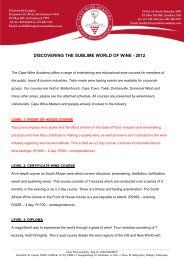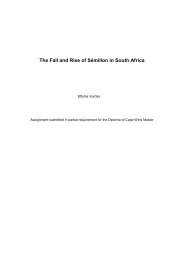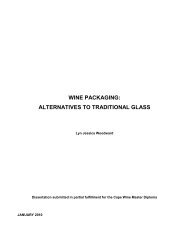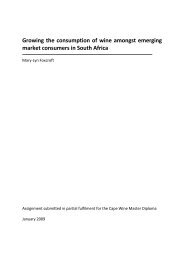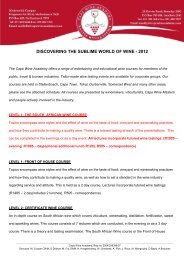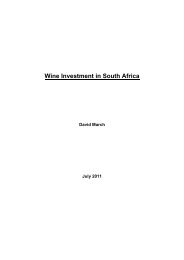micro-oxygenation in contemporary winemaking - Cape Wine ...
micro-oxygenation in contemporary winemaking - Cape Wine ...
micro-oxygenation in contemporary winemaking - Cape Wine ...
Create successful ePaper yourself
Turn your PDF publications into a flip-book with our unique Google optimized e-Paper software.
Micro-<strong>oxygenation</strong> <strong>in</strong> Contemporary W<strong>in</strong>emak<strong>in</strong>gw<strong>in</strong>e depends on the rate of oxygen addition. Rapid exposure to high doses of oxygenquickly overwhelms the w<strong>in</strong>e’s capacity result<strong>in</strong>g <strong>in</strong> oxidation and brown<strong>in</strong>g. However, thesame w<strong>in</strong>e could tolerate fairly large amounts of oxygen adm<strong>in</strong>istered <strong>in</strong> small dosesbecause the oxygen is slowly consumed through reactions with phenols. It is these slowoxygen-<strong>in</strong>duced polymerisation reactions that are implicated <strong>in</strong> the positive changesassociated with w<strong>in</strong>e age<strong>in</strong>g (Fulcrand et al., 2006; Ribéreau-Gayon et al., 2006a), and it isthese types of reactions that <strong>micro</strong>-<strong>oxygenation</strong> seeks to emulate (Lemaire et al., 2002;Bautista-Ortín et al., 2007).In addition to phenolic composition, a w<strong>in</strong>e’s ability to consume oxygen will also be<strong>in</strong>fluenced by other factors such as the availability of alternative substrates, anti-oxidantsand oxidation catalysts. The pr<strong>in</strong>cipal anti-oxidants <strong>in</strong> w<strong>in</strong>e <strong>in</strong>clude SO 2 and ascorbic acidwhile metal ions <strong>in</strong> w<strong>in</strong>e act as important catalysts of oxidation reactions (du Toit et al.,2006b; Danilewicz, 2007; de Basquiat, 2008). Yeast lees have a very high oxygenabsorptive capacity so the presence of lees will also significantly <strong>in</strong>crease a w<strong>in</strong>e’s ability toconsume oxygen (Fornairon-Bonnefond et al., 2003; Salmon, 2006; Mazauric and Salmon,2006).If the rate of oxygen addition is lower than the rate of oxygen consumption <strong>in</strong> phenolicreactions then oxygen will not accumulate <strong>in</strong> the w<strong>in</strong>e. So the optimal oxygen dose <strong>in</strong><strong>micro</strong>-<strong>oxygenation</strong> should not produce an <strong>in</strong>crease <strong>in</strong> the concentration of dissolvedoxygen (Paul, 2002). This pr<strong>in</strong>ciple is used <strong>in</strong> the monitor<strong>in</strong>g of <strong>micro</strong>-<strong>oxygenation</strong> (Pour-Nikfardjam and Dykes, 2003) but it should also be noted that the dissolved oxygenconcentration depends on the solubility of oxygen <strong>in</strong> w<strong>in</strong>e which is very temperaturedependent – w<strong>in</strong>e at 25°C and completely saturated with oxygen would conta<strong>in</strong> 7 mg O 2 /Lwhereas at 5°C the figure would <strong>in</strong>crease to 10 mg/L.5.2 APPLICATIONS OF MICRO-OXYGENATIONMicro-<strong>oxygenation</strong> is not appropriate for all w<strong>in</strong>es (Parish et al., 2000). Micro-<strong>oxygenation</strong>is simply another technique available to w<strong>in</strong>emakers and if used at all, its use must betailored to specific circumstances and particular w<strong>in</strong>es.Follow<strong>in</strong>g the potential benefits of <strong>micro</strong>-<strong>oxygenation</strong> listed <strong>in</strong> Section 4.1, some of thepotential applications of <strong>micro</strong>-<strong>oxygenation</strong> and the key choices that need to be made aresummarised <strong>in</strong> Table 3. The vast majority of <strong>micro</strong>-<strong>oxygenation</strong> applications have been <strong>in</strong>16



